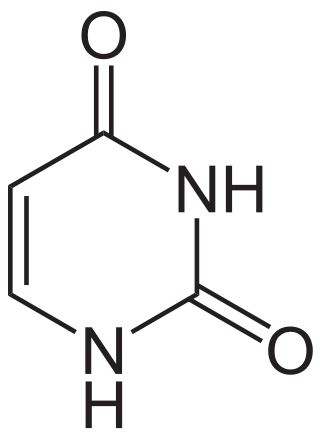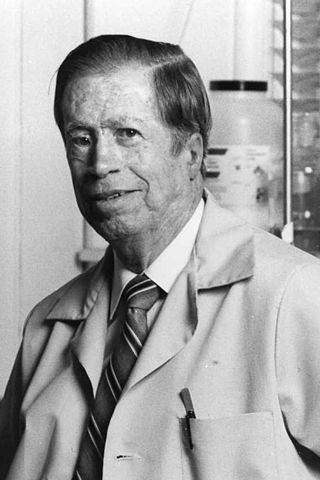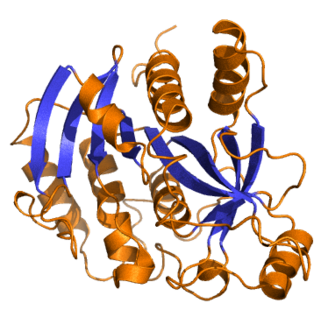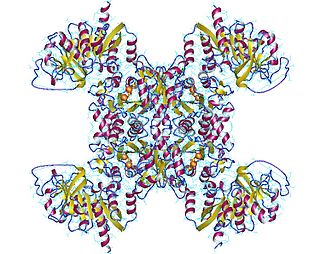
Cytosine is one of the four nucleobases found in DNA and RNA, along with adenine, guanine, and thymine. It is a pyrimidine derivative, with a heterocyclic aromatic ring and two substituents attached. The nucleoside of cytosine is cytidine. In Watson-Crick base pairing, it forms three hydrogen bonds with guanine.

Nucleotides are organic molecules composed of a nitrogenous base, a pentose sugar and a phosphate. They serve as monomeric units of the nucleic acid polymers – deoxyribonucleic acid (DNA) and ribonucleic acid (RNA), both of which are essential biomolecules within all life-forms on Earth. Nucleotides are obtained in the diet and are also synthesized from common nutrients by the liver.

Uracil is one of the four nucleobases in the nucleic acid RNA. The others are adenine (A), cytosine (C), and guanine (G). In RNA, uracil binds to adenine via two hydrogen bonds. In DNA, the uracil nucleobase is replaced by thymine (T). Uracil is a demethylated form of thymine.

Nucleobases are nitrogen-containing biological compounds that form nucleosides, which, in turn, are components of nucleotides, with all of these monomers constituting the basic building blocks of nucleic acids. The ability of nucleobases to form base pairs and to stack one upon another leads directly to long-chain helical structures such as ribonucleic acid (RNA) and deoxyribonucleic acid (DNA). Five nucleobases—adenine (A), cytosine (C), guanine (G), thymine (T), and uracil (U)—are called primary or canonical. They function as the fundamental units of the genetic code, with the bases A, G, C, and T being found in DNA while A, G, C, and U are found in RNA. Thymine and uracil are distinguished by merely the presence or absence of a methyl group on the fifth carbon (C5) of these heterocyclic six-membered rings. In addition, some viruses have aminoadenine (Z) instead of adenine. It differs in having an extra amine group, creating a more stable bond to thymine.

Hypoxanthine is a naturally occurring purine derivative. It is occasionally found as a constituent of nucleic acids, where it is present in the anticodon of tRNA in the form of its nucleoside inosine. It has a tautomer known as 6-hydroxypurine. Hypoxanthine is a necessary additive in certain cells, bacteria, and parasite cultures as a substrate and nitrogen source. For example, it is commonly a required reagent in malaria parasite cultures, since Plasmodium falciparum requires a source of hypoxanthine for nucleic acid synthesis and energy metabolism.

5-Methylcytosine is a methylated form of the DNA base cytosine (C) that regulates gene transcription and takes several other biological roles. When cytosine is methylated, the DNA maintains the same sequence, but the expression of methylated genes can be altered. 5-Methylcytosine is incorporated in the nucleoside 5-methylcytidine.
A nucleoside triphosphate is a nucleoside containing a nitrogenous base bound to a 5-carbon sugar, with three phosphate groups bound to the sugar. They are the molecular precursors of both DNA and RNA, which are chains of nucleotides made through the processes of DNA replication and transcription. Nucleoside triphosphates also serve as a source of energy for cellular reactions and are involved in signalling pathways.

Robert Bruce Merrifield was an American biochemist who won the Nobel Prize in Chemistry in 1984 for the invention of solid phase peptide synthesis.

Vidarabine or 9-β-D-arabinofuranosyladenine (ara-A) is an antiviral drug which is active against herpes simplex and varicella zoster viruses.

Purine nucleoside phosphorylase, PNP, PNPase or inosine phosphorylase is an enzyme that in humans is encoded by the NP gene. It catalyzes the chemical reaction

CTP synthase is an enzyme involved in pyrimidine biosynthesis that interconverts UTP and CTP.

Deoxycytidine kinase (dCK) is an enzyme which is encoded by the DCK gene in humans. dCK predominantly phosphorylates deoxycytidine (dC) and converts dC into deoxycytidine monophosphate. dCK catalyzes one of the initial steps in the nucleoside salvage pathway and has the potential to phosphorylate other preformed nucleosides, specifically deoxyadenosine (dA) and deoxyguanosine (dG), and convert them into their monophosphate forms. There has been recent biomedical research interest in investigating dCK's potential as a therapeutic target for different types of cancer.

Boranophosphates are salts with an anion consisting of borane (BH3) and phosphite groups. One of the simplest examples is [(CH3O)2OPBH3]−, prepared by base hydrolysis of the adduct of borane and trimethylphosphite.
Robert S. Coleman is an American chemistry professor and researcher. Coleman was a faculty member at both Ohio State University and the University of South Carolina. At Ohio State, he was on the faculty in the Department of Chemistry from 1996 to 2012, having moved to Ohio State as an associate professor from the University of South Carolina. At USC, Coleman taught as assistant professor from 1989 to 1995, and then as associate professor from 1995 to 1996. In 1996, he accepted a faculty position at Ohio State University to teach Organic Chemistry, where he was an associate professor from 1996 until 2000. He was promoted to full professor in 2000, teaching Organic Chemistry up until his retirement in 2012. He received his Ph.D. degree working with Professor Dale L. Boger, completing the first total synthesis of the antitumor agent CC-1065. He was subsequently an NIH postdoctoral fellow at Yale University with Professor Samuel J. Danishefsky, where he completed, the first total synthesis of the aglycone of the antitumor agent calicheamicin.

Cytidine deaminase is an enzyme that in humans is encoded by the CDA gene.
Charles Tanford was a German-born protein biochemist. He died in York, England, on October 1, 2009.
Jeremy Randall Knowles was a professor of chemistry at Harvard University who served as dean of the Harvard University faculty of arts and sciences (FAS) from 1991 to 2002. He joined Harvard in 1974, received many awards for his research, and remained at Harvard until his death, leaving the faculty for a decade to serve as Dean. Knowles died on 3 April 2008 at his home.
Gordon G. Hammes is a distinguished service professor of biochemistry, emeritus, at Duke University, professor emeritus at Cornell University, and member of United States National Academy of Sciences. Hammes' research involves the study of enzyme mechanisms and enzyme regulation.
Katherine Seley-Radtke is an American medicinal chemist who specializes in the discovery and design of novel nucleoside or nucleotide based enzyme inhibitors that may be used to treat infections or cancer. She has authored over 90 peer-reviewed publications,is an inventor of five issued US patents, and is a professor in the department of chemistry and biochemistry at the University of Maryland, Baltimore County. Her international impact includes scientific collaborations, policy advising and diplomatic appointments in biosecurity efforts.
Kenichi Yokoyama is an enzymologist, chemical biologist, and natural product biochemist originally from Tokyo, Japan. He is an Associate Professor of Biochemistry at Duke University School of Medicine. In 2019, Yokoyama was awarded the Pfizer Award in Enzyme Chemistry from the American Chemical Society.













